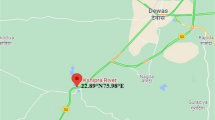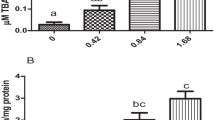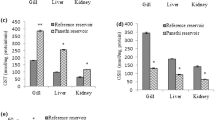Abstract
Studies on heavy metal induced toxicity have been conducted in many water bodies across the globe and such effects have been evaluated in various fish species. The present study was designed to determine the load of some heavy metals in select sites in Southern Assam, India, along with estimating their concentration in tissues of Channa punctatus Bloch. inhabiting those niches. The effect of heavy metals in oxystress generation, genotoxicity and subsequent immune response in fish was also evaluated. In all of these sites, the concentration of Hg, Cd, Pb and Cr were above the permissible ranges while their concentrations were several folds higher in the piscine tissues due to bioaccumulation and possible biomagnification. Kidney showed the highest metal pollution index followed by liver and gills. Generation of ROS was significantly elevated and that in turn triggered oxystress, as is evident from enhanced lipid peroxidation, protein carbonylation and respiratory burst activity. These were in association with the compromised antioxidant enzyme levels with concomitant damage to DNA as evident from Comet parameters. The innate immune potential was significantly impaired as evident from the compromised cell adhesion, phagocytosis, intracellular killing activity in head kidney macrophages (HKM) along with decreased release of nitric oxide (NO) and myeloperoxidase (MPO). Immunosuppression was further validated at protein levels where compromised release of cytokines viz. TNF-α, IL-1β, IL-6, IL-10 and IL-12 and cell signaling molecules iNOS and NF-κβ were noted. Thus the present study indicates genotoxicity along with a compromise in immune status of Channa punctatus Bloch. living in a habitat laden with heavy metals.
Highlights
-
Heavy metal concentrations in select water bodies above the WHO, EPA, IS limits.
-
Accumulation of heavy metals in fish tissues are above the FAO set range.
-
MPI is maximum in the kidney followed by liver and gill of Channa punctatus.
-
Metal induced oxidative stress, genotoxicity and compromised innate immune potential.
-
Heavy metal induced decreased cytokine release and immunocompromised state.





Similar content being viewed by others
References
Afshan S, Ali S, Shaista Ameen U, Farid M, Bharwana S, Hannan F, Ahmad R (2014) Effect of different heavy metal pollution on fish. Res J Chem Environ Sci 2:74–79
APHA (2005) Standard methods for the examination of water and wastewater analysis, 21st Edition. American Water Works Association/Water Environment Federation, Washington D.C
Bakshi A, Panigrahi AK (2018) A comprehensive review on chromium induced alterations in fresh water fishes. Toxicol Rep 5:440–447. https://doi.org/10.1016/j.toxrep.2018.03.007
Begam M, Sengupta M (2015) Immunomodulation of intestinal macrophages by mercury involves oxidative damage and rise of pro-inflammatory cytokine release in the fresh water fish Channa punctatus. Bloch Fish Shellfish Immunol 45:378–385
Blewett TA, Leonard EM (2017) Mechanisms of nickel toxicity to fish and invertebrates in marine and estuarine waters. Environ Poll 223:311–322. https://doi.org/10.1016/j.envpol.2017.01.028
Bos AR, Weaver RA, Roos D (1990) Characterization and qualification of the peroxidase in human neutrophils Biochimica et Biophysica Acta: 4133-4141
Bradford MM (1976) A rapid and sensitive method for the quantitation of microgram quantities of protein utilizing the principle of protein-dye binding. Anal Biochem 72:248–254. https://doi.org/10.1006/abio.1976.9999
Choudhury C, Mazumder R, Biswas R, Sengupta M (2021) Cadmium exposure induces inflammation through the canonical NF-κΒ pathway in monocytes/macrophages of Channa punctatus. Bloch Fish Shellfish Immunol 110:116–126. https://doi.org/10.1016/j.fsi.2021.01.002
Choudhury C, Mazumder R, Kumar R, Dhar B, Sengupta M (2020) Cadmium induced oxystress alters Nrf2-Keap1 signaling and triggers apoptosis in piscine head kidney macrophages. Aquatic Toxicol 231:105739. https://doi.org/10.1016/j.aquatox.2020.105739
Choudhury MG, Saha N (2015) Nitric oxide synthetic machineries and possible roles of nitric oxide in various physiological functions in fish. In Advances in Fish Research. Narendra Publishing House, Delhi, India, p 29–67
Claiborne A (1985) Catalase activity. In: Greenwald RA (Ed.) CRC handbook of methods in oxygen radical research. CRC Press, Boca Raton, FL, p 283–284
Costa MM, Maehr T, Diaz-Rosales P, Secombes CJ, Wang T (2011) Bioactivity studies of rainbow trout (Oncorhynchus mykiss) interleukin-6: effects on macrophage growth and antimicrobial peptide gene expression. Mol Immunol 48:1903–1916. https://doi.org/10.1016/j.molimm.2011.05.027
Das S, Choudhury SS (2015) Analysis of heavy metals from water, sediment, and tissues of Labeo angra (Hamilton, 1822), from an Ox-box lake- an wetland site from Assam, India. J Environ Sci Health Part A:1-13. https://doi.org/10.1080/10934529.2015.1079102
Dekić R, Savic N, Manojlović M, Golub D, Pavličević J (2016) Condition factor and organosomatic indices of rainbow trout (Oncorhynchus mykiss, Wal.) from different broodstock. Biotechnol Animal Husb 32:229–237
EPA (2018) 2018 edition of the drinking water standards and health advisories tables. U.S. Environmental Protection Agency (EPA), Washington, DC
Fang FC (2004) Antimicrobial reactive oxygen and nitrogen species: concepts and controversies. Nat Rev Microbiol 2:820–832. https://doi.org/10.1038/nrmicro1004
FAO (1983) Food and Agricultural Organization (FAO). Compilation of legal limits for hazardous substances in fish and fishery products. Fishery Circ No 464:5–100
Farsani MN, Haghparast RJ, Naserabad SS, Moghadas F, Bagheri T, Gerami MH (2019) Seasonal heavy metal monitoring of water, sediment and common carp (Cyprinus carpio) in Aras Dam Lake of Iran. Int J Aquatic Biol 7:123–131. https://doi.org/10.22034/ijab.v7i3.597
Fedorova M, Bollineni RC, Hoffmann R (2014) Protein carbonylation as a major hallmark of oxidative damage: update of analytical strategies. Mass Spectrom Rev 33:79–97. https://doi.org/10.1002/mas.21381
Fujiki K, Yano T (1997) Effects of sodium alginate on the non-specific defence system of the common carp (Cyprinus carpioL.). Fish Shellfish Immunol 7:417–427
Guo SN, Zheng JL, Yuan SS, Zhu QL, Wu CW (2017) Immunosuppressive effects and associated compensatory responses in zebrafish after full life-cycle exposure to environmentally relevant concentrations of cadmium. Aquatic Toxicol 188:64–71. https://doi.org/10.1016/j.aquatox.2017.04.014
Gupta P, Srivastava N (2006) Effects of sub-lethal concentrations of zinc on histological changes and bioaccumulation of zinc by kidney of fish Channa punctatus (Bloch). J Environ Biol 27:211–215.
Hirano T (2010) Interleukin 6 in autoimmune and inflammatory diseases: a personal memoir. Proc Jpn Acad Ser B Phys Biol Sci 86:717–730. https://doi.org/10.2183/pjab.86.717
Hong S, Li R, Xu Q, Secombes CJ, Wang T (2013) Two types of TNF-alpha exist in teleost fish: phylogeny, expression, and bioactivity analysis of type-II TNF-alpha3 in rainbow trout Oncorhynchus mykiss. J Immunol 191:5959–5972. https://doi.org/10.4049/jimmunol.1301584
Htun‐Han M (1978) The reproductive biology of the dab Limanda limanda (L.) in the North Sea: gonosomatic index, hepatosomatic index and condition factor. J Fish Biol 13:369–378
IS (2004) Indian standard. Drinking Water Specification, Indian Standard (IS 10500:2004), 2nd revision, Indian Standard, New Delhi, p 2004
Javed M, Ahmad I, Usmani N, Ahmad M (2016) Bioaccumulation, oxidative stress and genotoxicity in fish (Channa punctatus) exposed to a thermal power plant effluent. Ecotoxicol Environ Saf 127:163–169
Javed M, Usmani N (2011) Accumulation of heavy metals in fishes: a human health concern. Int J Environ Sci 2:659
Javed M, Usmani N (2016) Accumulation of heavy metals and human health risk assessment via the consumption of freshwater fish Mastacembelus armatus inhabiting, thermal power plant effluent loaded canal. SpringerPlus 5:776. https://doi.org/10.1186/s40064-016-2471-3
Kar D, Nagarathna AV, Ramachandra TV, Dey SC (2006) Fish diversity and conservation aspects in an aquatic ecosystem in NorthEastern India ZOOS Print. Journal 21:2308–2315
LeBel CP, Ischiropoulos H, Bondy SC (1992) Evaluation of the probe 2’,7’-dichlorofluorescin as an indicator of reactive oxygen species formation and oxidative stress. Chem Res Toxicol 5:227–231. https://doi.org/10.1021/tx00026a012
Levine RL, Williams JA, Stadtman EP, Shacter E (1994) Carbonyl assays for determination of oxidatively modified proteins. Methods Enzymol 233:346–57
Marklund S, Marklund G (1974) Involvement of the superoxide anion radical in the autoxidation of pyrogallol and a convenient assay for superoxide dismutase. Eur J Biochem 47:469–474
Mylonas C, Kouretas D (1999) Lipid peroxidation and tissue damage. In Vivo 13:295–309
Ozmen M, Güngördü A, Kucukbay FZ, Güler RE (2006) Monitoring the effects of water pollution on Cyprinus carpio in Karakaya Dam Lake, Turkey. Ecotoxicology 15:157–169. https://doi.org/10.1007/s10646-005-0045-1
Paul N, Chakraborty S, Sengupta M (2014) Lead toxicity on non-specific immune mechanisms of freshwater fish Channa punctatus. Aquat Toxicol 152:105–112
Pritchard JB (1993) Aquatic toxicology: past, present, and prospects. Environ Health Perspect 100:249–257. https://doi.org/10.1289/ehp.93100249
Rana MN, Tangpong J, Rahman MM (2018) Toxicodynamics of lead, cadmium, mercury and arsenic- induced kidney toxicity and treatment strategy: a mini review. Toxicol Rep 5:704–713. https://doi.org/10.1016/j.toxrep.2018.05.012
Saha RN, Pahan K (2006) Regulation of inducible nitric oxide synthase gene in glial cells. Antioxid Redox Signal 8:929–947. https://doi.org/10.1089/ars.2006.8.929
Sasaki M et al. (2000) Dynamic regulation of neuronal NO synthase transcription by calcium influx through a CREB family transcription factor-dependent mechanism. Proc Natl Acad Sci 97:8617–8622. https://doi.org/10.1073/pnas.97.15.8617
Schreck C, Moyle P (1990) Methods for fish biology. American Fisheries Society, Bethesda, Md, USA
Secombes CJ (1990) Isolation of salmoid macrophages and analysis of their killing activity. Tech Fish Immunol 1:137–155
Secombes CJ, Wang T (2012) The innate and adaptive immune system of fish. In Infectious Disease in Aquaculture: Prevention and Control. Woodhead Publishing Limited, United Kingdom, p 3–68
Silva EPD et al. (2020) Genotoxic effect of heavy metals on Astyanax lacustris in an urban stream. Heliyon 6:e05034. https://doi.org/10.1016/j.heliyon.2020.e05034
Singh NP, McCoy MT, Tice RR, Schneider EL (1988) A simple technique for quantitation of low levels of DNA damage in individual cells. Exp Cell Res 175:184–191. https://doi.org/10.1016/0014-4827(88)90265-0
Sunjog K et al. (2012) Heavy metal accumulation and the genotoxicity in barbel (Barbus barbus) as indicators of the danube river pollution. Sci World J 2012:351074. https://doi.org/10.1100/2012/351074
Tice RR et al. (2000) Single cell gel/comet assay: guidelines for in vitro and in vivo genetic toxicology testing. Environ Mol Mutagen 35:206–221. https://doi.org/10.1002/(sici)1098-2280(2000)35:3<206::aid-em8>3.0.co;2-j
Tlenshieva AM, Witeska M, Shalakhmetova TM (2022) Genotoxic and histopathological effects of the Ili River (Kazakhstan) water pollution on the grass carp Ctenopharyngodon idella. Environ Pollut Bioavailab 34:297–307. https://doi.org/10.1080/26395940.2022.2101544
Usero J, Gonzalez-Regalado E, Gracia I (1997) Trace metals in the bivalve molluscs Ruditapes decussatus and ruditapes philippinarum from the Atlantic Coast of southern Spain. Environ Int 23:291–298
Utley HG, Bernheim F, Hochstein P (1967) Effect of sulfhydryl reagents on peroxidation in microsomes. Arch Biochem Biophys 118:29–32. https://doi.org/10.1016/0003-9861(67)90273-1
Valavanidis A, Vlahogianni T, Dassenakis M, Scoullos M (2006) Molecular biomarkers of oxidative stress in aquatic organisms in relation to toxic environmental pollutants. Ecotoxicol Environ Saf 64:178–189. https://doi.org/10.1016/j.ecoenv.2005.03.013
Vos J, Van Loveren H, Wester P, Vethaak D (1989) Toxic effects of environmental chemicals on the immune system. Trends Pharmacol Sci 10:289–292. https://doi.org/10.1016/0165-6147(89)90031-X
Wang T, Husain M, Hong S, Holland JW (2014) Differential expression, modulation and bioactivity of distinct fish IL-12 isoforms: implication towards the evolution of Th1-like immune responses. Eur J Immunol 44:1541–1551. https://doi.org/10.1002/eji.201344273
Weeks BA, Anderson DP, DuFour AP, Fairbrother A, Goven AJ, Lahvis GP, Peters G (1992) Immunological biomarkers to assess environmental stress. Lewis Publishers, Boca Raton, LA, United States.
WHO (2008) Guidelines for drinking-water quality, Volume 1: Recommendations, 3rd ed., incorporating the first and second addenda. World Health Organization (WHO), Geneva, p 2008
Zelikoff JT (1998) Biomarkers of immunotoxicity in fish and other non-mammalian sentinel species: predictive value for mammals? Toxicology 129:63–71. https://doi.org/10.1016/s0300-483x(98)00064-x
Zelikoff JT, Smialowicz R, Bigazzi PE, Goyer RA, Lawrence DA, Maibach HI, Gardner D (1994) Immunomodulation by metals. Fundam Appl Toxicol 22:1–7. https://doi.org/10.1006/faat.1994.1001
Acknowledgements
The authors gratefully acknowledge the Sophisticated Analytical Instrument Facility (SAIF), NEHU, Shillong, Meghalaya. This research was conducted in compliance with all relevant federal guidelines and institutional policies.
Author information
Authors and Affiliations
Contributions
CC carried out the whole experimental work and drafted the manuscript. RD helped in experimental work. DB and SG guided in comet analysis. RM helped in statistical analysis while MS helped in supervising the work, designing the experiments and evaluating the manuscript.
Corresponding author
Ethics declarations
Conflict of interest
The authors declare no competing interests.
Supplementary information
Rights and permissions
Springer Nature or its licensor (e.g. a society or other partner) holds exclusive rights to this article under a publishing agreement with the author(s) or other rightsholder(s); author self-archiving of the accepted manuscript version of this article is solely governed by the terms of such publishing agreement and applicable law.
About this article
Cite this article
Choudhury, C., Giri, S., Mazumder, R. et al. Heavy metal bioaccumulation triggers oxystress, genotoxicity and immunomodulation in head kidney macrophages of Channa punctatus Bloch. Ecotoxicology 32, 553–568 (2023). https://doi.org/10.1007/s10646-023-02659-2
Accepted:
Published:
Issue Date:
DOI: https://doi.org/10.1007/s10646-023-02659-2




